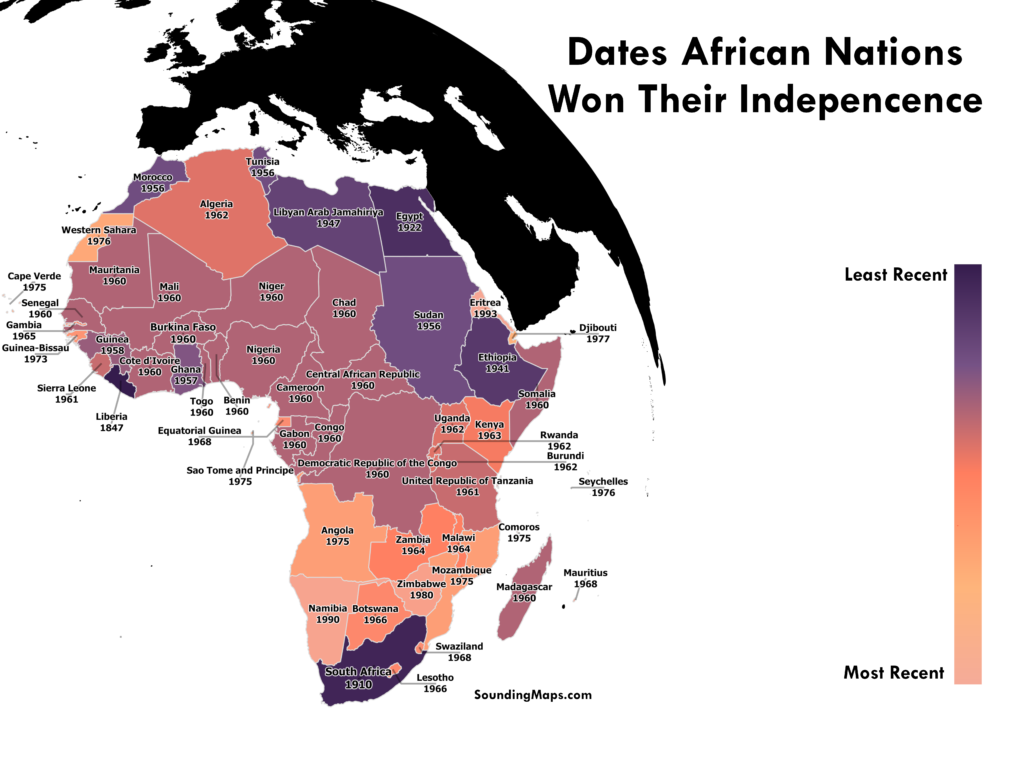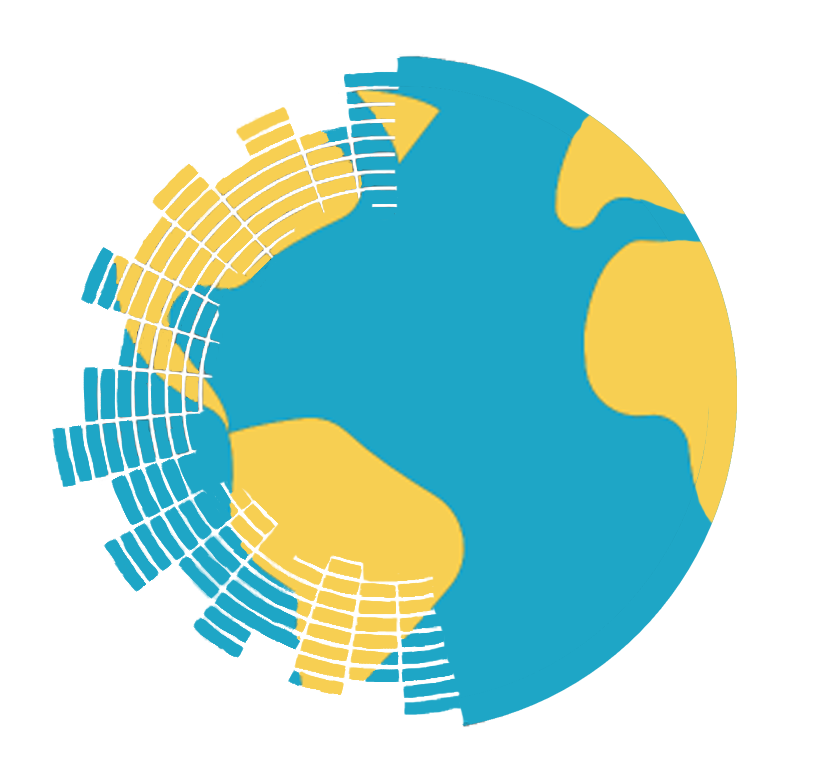
The Year of African Independence Dates
This map shows each African nation’s independence dates. 1960 is referred to as The Year of Africa, mainly because of the independence of seventeen African countries. Most gained independence from Belgium, France, and the United Kingdom.
Following most African colonization between 1880 and 1900, the struggle for independence began after World War II. Over the 20th century, colonization was slowly then rapidly reversed.
Why was Africa Easily Colonized?
Like most conquests, divide and conquer always had a place in history. The rivalries between African leaders, chiefs, and kings were heavily played against one another by the European leaders. In most cases, persuasion, promises, and rewards were used to take advantage of the situation.
It gets worse:
European powers could take control of any land by using force and violence. The advent of advanced technology, such as the machine gun, allowed Europe to steam-roll any opposing African forces. African armies were unable to get their hands on this weapon.
Besides military technology, natural disasters played a significant role in abating African progress. Severe droughts, locusts ravished crops, and plagued livestock all weakened the African population physically and mentally.
The third catalyst of the African conquest was disease. Smallpox was breaking out in a range of epidemics. The native population had never developed natural immunity like the Europeans. The lack of immunity and resistance to this disease weakened the African population further.
With the lack of military technology, the constant barrage of natural disasters, and the invisible yet looming disease, Africa was conquered.
The Countries that Colonized Africa
Which countries were independence fought against anyway?
African Independence From France
Under Charles De Gaulle, France allowed member states of its newly formed “French Community” federation to declare independence. Obviously, all did. Surprisingly to France, at a much faster rate than anticipated.
The countries that declared independence from France were:
- Cameroon
- Togo
- Mali Federation
- Madagascar
- Dahomey (renamed to Benin in 1975)
- Niger
- Upper Volta (renamed to Burkina Faso in 1984)
- Ivory Coast (Côte d’Ivoire)
- Chad
- Central African Republic
- Republic of the Congo
- Gabon
- Mauritania
Although independent, these countries remained under economic French influence. Many of these countries inherited French constitutional customs, including values of democracy, universal rights, and the parliamentary system practiced in France and other European countries.
African Independence From the United Kingdom
Only two countries gained independence from the British Empire. Somalia, through the unification of British Somaliland and the Trust Territory of Somalia and Nigeria.
But here’s the kicker:
Nigeria had the largest population and economy on the continent. This allowed the UK to exert fierce, concentrated control over a large population within one country.
Don’t let this fool you:
Although Nigeria had a vast population, it didn’t have a unified culture. The country was embroiled in civil strife frequently.
African Independence From Belgium
The future Prime Minister of the Republic of the Congo – Patrice Lumumba – was imprisoned for inciting a riot in 1959. Belgium recognized the looming independence. Seeing this, Lumumba was freed and allowed to attend the Brussels conference set to establish freedom for the Republic of the Congo.
Returning home, Lumumba won elections and became Prime Minister of the country.
Unfortunately, it gets worse:
The country soon faced civil unrest, and Lumumba was kicked out of office. He was tortured and executed after. This period of instability is known as the Congo Crisis.
List of Independence Dates by African Country and Year
Liberia was the first nation to recognize independence long before most other nations realized the earliest independence date in 1847. The most recent African country to gain independence was Eritrea in 1993.
- Liberia 1847
- Republic of South Africa 1910
- Arab Republic of Egypt 1922
- People’s Democratic Republic of Ethiopia 1941
- Libya 1951
- Democratic Republic of Sudan 1956
- Kingdom of Morocco 1956
- Republic of Tunisia 1956
- Republic of Ghana 1957
- Republic of Guinea 1958
- Republic of Cameroon 1960
- Republic of Senegal 1960
- Republic of Togo 1960
- Republic of Mali 1960
- Democratic Republic of Madagascar 1960
- Democratic Republic of Congo 1960
- Democratic Republic of Somalia 1960
- Republic of Benin 1960
- Republic of Niger 1960
- Popular Democratic Republic of Burkina 1960
- Republic of Côte d’Ivoire 1960
- Republic of Chad 1960
- Central African Republic 1960
- Republic of the Congo 1960
- Republic of Gabon 1960
- Federal Republic of Nigeria 1960
- Islamic Republic of Mauritania 1960
- Republic of Sierra Leone 1961
- Nigeria (British Cameroon North) 1961
- Cameroon 1961
- United Republic of Tanzania 1961
- Republic of Burundi 1962
- Republic of Rwanda 1962
- Democratic and Popular Republic of Algeria 1962
- Republic of Uganda 1962
- Republic of Kenya 1963
- Republic of Malawi 1964
- Republic of Zambia 1964
- Republic of The Gambia 1965
- Republic of Botswana 1966
- Kingdom of Lesotho 1966
- State of Mauritius 1968
- Kingdom of Swaziland 1968
- Republic of Equatorial Guinea 1968
- Republic of Guinea-Bissau 1969
- Republic of Mozambique 1975
- Republic of Cape Verde 1975
- Federal Islamic Republic of Comoros 1975
- Democratic Republic of São Tomé and Principe 1975
- People’s Republic of Angola 1975
- Western Sahara 1976
- Republic of Seychelles 1976
- Republic of Djibouti 1977
- Republic of Zimbabwe 1980
- Republic of Namibia 1990
- State of Eritrea 1993
This map was created using QGIS. A free and open-source GIS tool.

3 thoughts on “Mapping The Year of African Independence Dates”
Why 1980 for Zimbabwe but 1910 for South Africa? Why consider the date Ethiopia kicked out Italian invaders as “independence”? Where’s South Sudan? This is a rather misleading map.
Ethiopia is usually considered to have never been colonized, but following the invasion by Italy in 1935-36 Italian settlers arrived. Emperor Haile Selassie was deposed and went into exile in the UK. He regained his throne on 5 May 1941 when he re-entered Addis Ababa with his troops. Italian resistance was not completely overcome until 27th November 1941.
Very good